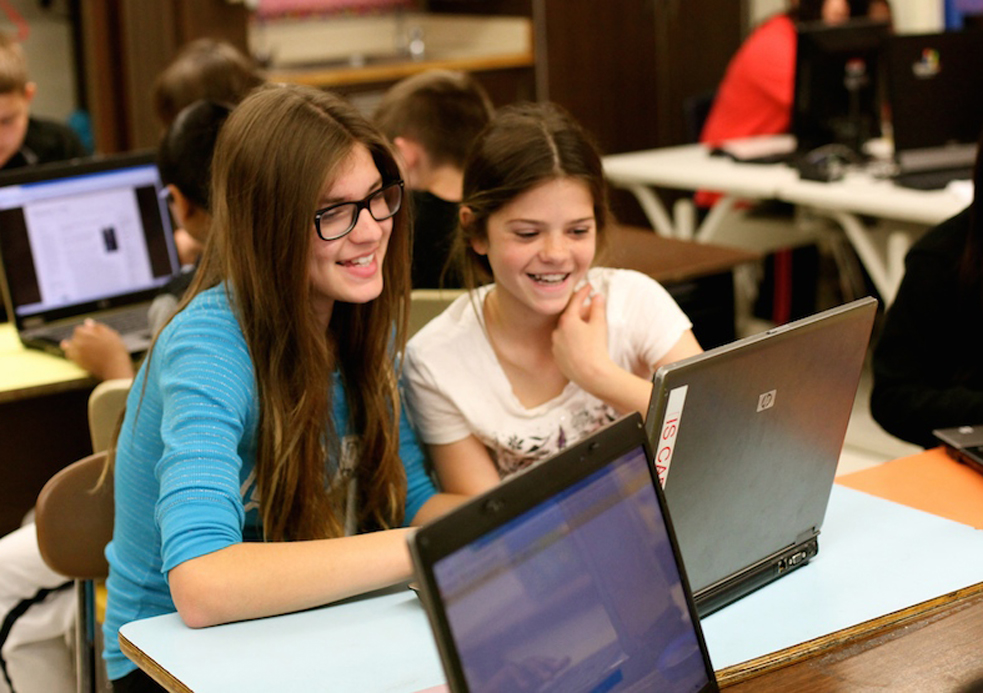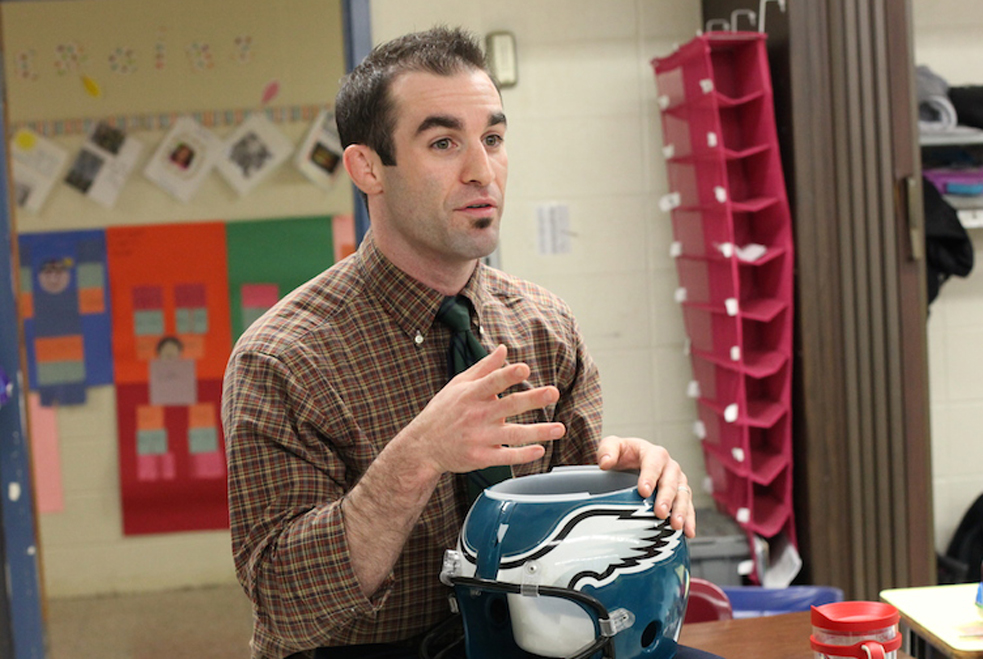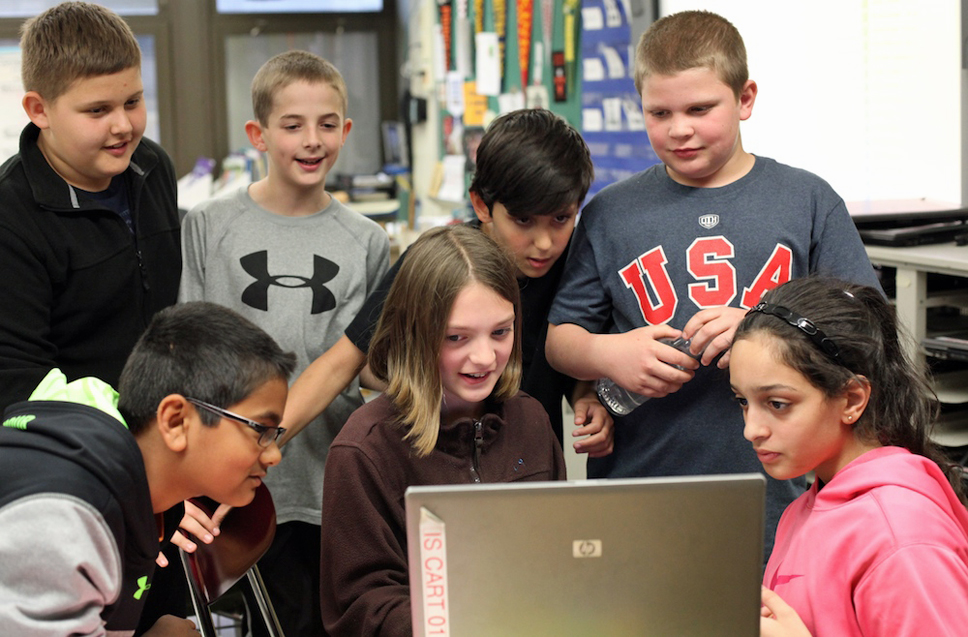
Two students in Mr. J’s class laugh as they teach themselves about Mercy Otis Warren and the American Revolution. Photo: Natasha Scripture
Eleven-year-olds running a classroom? That could sound outlandish to some elementary school teachers, but not to Joe Jamison, or “Mr. J” as he is affectionately called by his fifth-grade students at Lawrence Intermediate School in central New Jersey.
“I learn from my kids,” says Mr. J, as he dips his hand into a Philadelphia Eagles football helmet — otherwise known as the “helmet of fate” — and pulls out the name of the next group of students to give a presentation on Mercy Otis Warren, an American playwright and poet, not to mention one of the few female propagandists of the American Revolution, which Mr. J’s class is studying.
There is a feeling of excitement in the small classroom, decorated with inspirational quotes and bright educational paraphernalia. The kids sit at the edge of their seats, waiting in anticipation; they are eager to show their findings after spending an hour researching and putting together a presentation about a quote that Mr. J projected on a whiteboard at the front of the classroom: “The rights of the individual should be the primary object of all governments.” In groups, they were asked to figure out the significance of the quote, using only their critical faculties and a few laptops.
This activity is part of Mr. J’s bi-weekly SOLE session, a freestyle learning period revolving around a topic, quote or question. SOLE, which stands for Self-Organized Learning Environment, is a concept drawn from 2013 TED Prize winner Sugata Mitra’s wish in which he offered up a new vision of education that combines the vast resources of the Internet with children’s innate sense of curiosity. The School in the Cloud, as he calls it, is a global experiment in self-organized learning. SOLEs let kids puzzle through big questions and ideas on their own, teaching each other in the process.
More from the TED Prize Blog: Karachi’s youth paint “pictures of peace”
“The biggest thing for me is to prepare my students for the real world, to teach them essential skills such as critical thinking,” says Mr. J, who was inspired to action after watching Mitra’s 2014 TED Talk. “I believe in taking risks. If you’re right all the time you’re not going to learn anything. I believe in pushing my students out of their comfort zones, because that is where the real learning and personal growth happens.”
Mr. J was recently awarded the 2013-2014 New Jersey Governor’s Teacher Recognition Award, given to one teacher at every school in the state. It’s a testament to his popularity among his students. He strikes a precious balance between providing gentle instruction and mentorship, and giving students the freedom to explore on their own. “I’m trying to teach my students how to think. This is a process: learning where to find good, quality information and determine how relevant it is to the question being posed. How do you boil it all down to a two-minute presentation? This is what I call critical thinking,” he says.

Mr. Jamison holds the “helmet of fate,” an integral part of the weekly SOLE in his 5th grade classroom. Photo: Natasha Scripture
His students are flexible and receptive to working in different ways. “I usually work independently, so for me it is a good opportunity to work in a group,” says Madeline, 11, who admits she was skeptical of the SOLE concept at first. “I like the Internet because you have access to a lot of newer things. In books you can’t get things that are going on, like, yesterday because books take a long time to be written,” she says.
Hadi, 11, also enjoys SOLE sessions. “I like how we get to be independent and collaborate with our friends and talk it out instead of the teacher teaching us,” he says. Hadi, whose favorite subject is math, has his own laptop and plans on being either a doctor or lawyer.
“I think computers are faster and more efficient, especially when you know what you’re doing,” says Natalie, 10, who envisions a career as an architect. She is a big fan of Mr. J. “He is more open to social media and I think that’s very interesting because not a lot of teachers are like that. He is more open to our generation,” she says.
Mr. J knew he wanted to be a teacher since he was a sophomore in high school. His passion for teaching, love of social media and curiosity about educational trends drive him to explore new options like Mitra’s School in the Cloud platform, which helps students conduct research and create presentations. “There is no single formula. Every teacher, every situation is different. I have to set it up in a way that I know is going to work for my kids,” says Mr. J.
More from the TED Prize Blog: Calling documentary filmmakers…
Other adults in the school notice Mr. J’s willingness to try new teaching techniques, and have been experimenting with self-organized learning in their classrooms as well. It is clear that technology is a priority at the school. “This is all about the 21st-century learning,” said David Adam, principal of Lawrence Intermediate School. “We’ve got to get on board now, otherwise our students will be behind.”
Wikipedia and Google are two of the go-to websites for students as they conduct their research, but they are quite adept at navigating their way into less familiar terrain too, clicking on a series of hyperlinks that pull them into offbeat historical websites or down into the bottomless pit of YouTube. As they go, there is a sense of camaraderie and unity. Together, each group decides what snippets of research should feed into their presentation, taking turns using a shared computer. While one clicks on the mouse, another takes notes, and another student perhaps will ponder the meaning of the quote and make a suggestion.

A group of students huddles around as they discuss how to do their presentation. Photo: Natasha Scripture
As each cluster of kids delivers their presentations, the diversity of content is striking — they use multimedia add-ons and offer philosophical musings, memorable for their uniqueness. From finding a quirky, informative, YouTube video where students from another school impersonate Mercy Otis Warren during the American Revolution, to making statements like, “Mr. J gave us this quote because in the olden days women’s opinions never really mattered to people but hers did,” it’s clear that the kids enjoy the limitless creative leverage.
While textbooks are clearly not obsolete, schools like Lawrence Intermediate School are learning to adapt to the impact the Internet is having on students — and figuring out how to take advantage of what it has to offer. In the end, there is no single right way to get kids engaged in learning, but it’s clear that these kids, at least, who are working in a SOLE environment feel a sense of empowerment, confidence and maturity. Perhaps teaching a child to how to think critically is the gift that keeps on giving.
This post originally ran on the TED Prize Blog. Read more »
Comments (5)